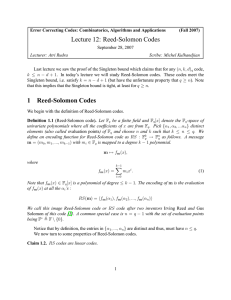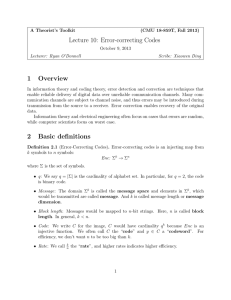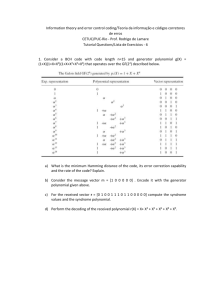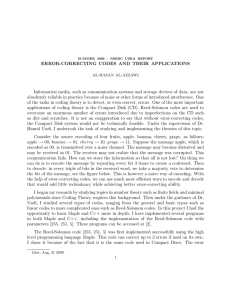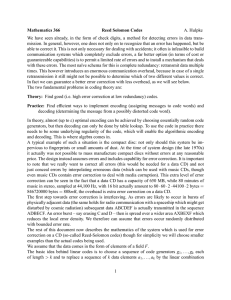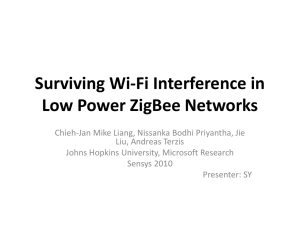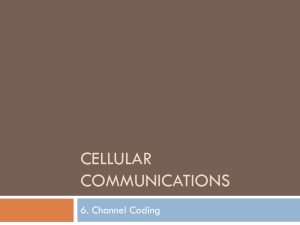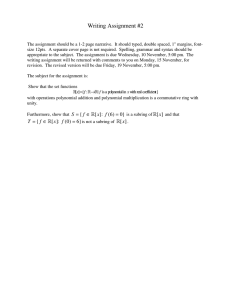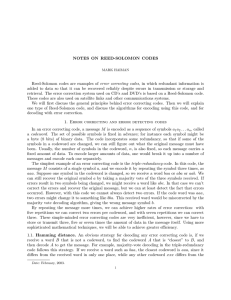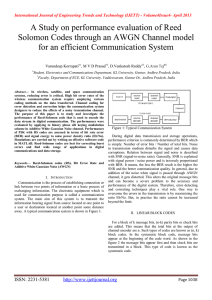February 26: Error correcting codes Contents
advertisement
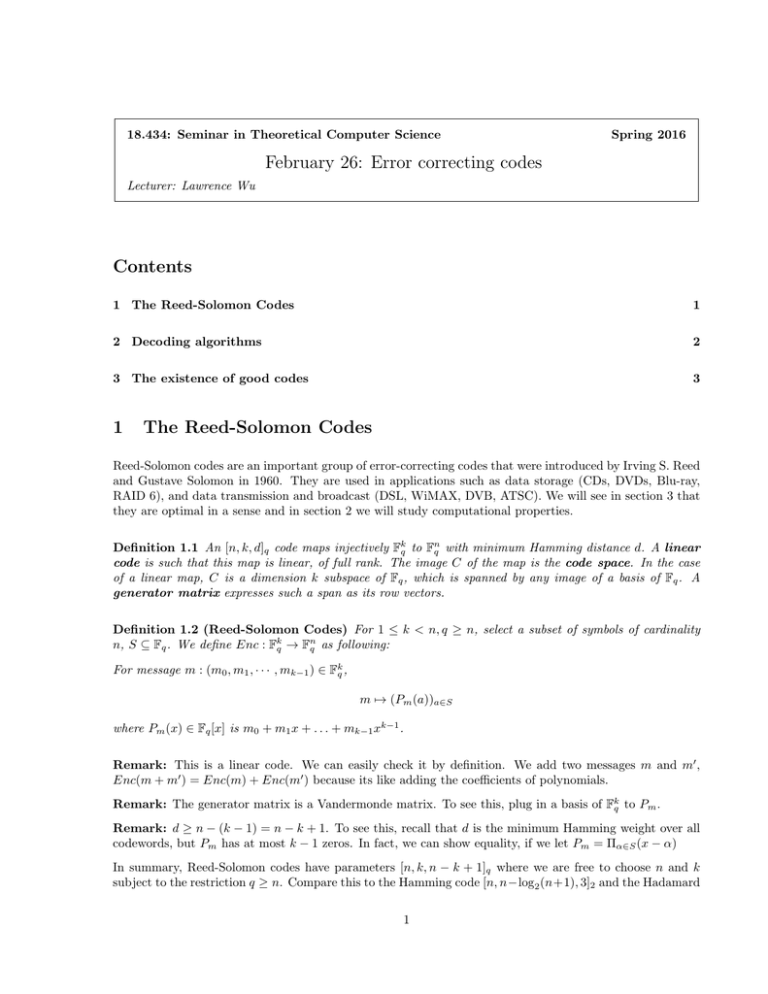
18.434: Seminar in Theoretical Computer Science
Spring 2016
February 26: Error correcting codes
Lecturer: Lawrence Wu
Contents
1 The Reed-Solomon Codes
1
2 Decoding algorithms
2
3 The existence of good codes
3
1
The Reed-Solomon Codes
Reed-Solomon codes are an important group of error-correcting codes that were introduced by Irving S. Reed
and Gustave Solomon in 1960. They are used in applications such as data storage (CDs, DVDs, Blu-ray,
RAID 6), and data transmission and broadcast (DSL, WiMAX, DVB, ATSC). We will see in section 3 that
they are optimal in a sense and in section 2 we will study computational properties.
Definition 1.1 An [n, k, d]q code maps injectively Fkq to Fnq with minimum Hamming distance d. A linear
code is such that this map is linear, of full rank. The image C of the map is the code space. In the case
of a linear map, C is a dimension k subspace of Fq , which is spanned by any image of a basis of Fq . A
generator matrix expresses such a span as its row vectors.
Definition 1.2 (Reed-Solomon Codes) For 1 ≤ k < n, q ≥ n, select a subset of symbols of cardinality
n, S ⊆ Fq . We define Enc : Fkq → Fnq as following:
For message m : (m0 , m1 , · · · , mk−1 ) ∈ Fkq ,
m 7→ (Pm (a))a∈S
where Pm (x) ∈ Fq [x] is m0 + m1 x + . . . + mk−1 xk−1 .
Remark: This is a linear code. We can easily check it by definition. We add two messages m and m0 ,
Enc(m + m0 ) = Enc(m) + Enc(m0 ) because its like adding the coefficients of polynomials.
Remark: The generator matrix is a Vandermonde matrix. To see this, plug in a basis of Fkq to Pm .
Remark: d ≥ n − (k − 1) = n − k + 1. To see this, recall that d is the minimum Hamming weight over all
codewords, but Pm has at most k − 1 zeros. In fact, we can show equality, if we let Pm = Πα∈S (x − α)
In summary, Reed-Solomon codes have parameters [n, k, n − k + 1]q where we are free to choose n and k
subject to the restriction q ≥ n. Compare this to the Hamming code [n, n−log2 (n+1), 3]2 and the Hadamard
1
2
Error correcting codes
code [n, log2 n, n/2]2 . The Reed-Solomon code can beat these codes in rate and error correction with setting
k = log2 (n + 1) and k = n/2 respectively, but needs a larger alphabet. An intuition for why a larger alphabet
would help is that larger symbols can absorb more errors (e.g. an alphabet size of 1024 would have 10 bit
symbols which could absorb 10 consective errors).
2
Decoding algorithms
In this section, we consider only the problem of unique decoding, in which we assume that a received message
has less than d/2 errors, so that by the Triangle Inequality there is a unique codeword within d/2 of the
2
received
√ message, from which the original message can be recovered. See [1] for O(n ) list decoding of up to
1 − R errors in Reed-Solomon codes.
Here we present the Welch-Berlekamp Algorithm for unique decoding and correction of up to e <
errors. We can express the received code word in terms of the polynomial
Pm (X) = m0 + m1 X + . . . + mk−1 X k−1
n−k+1
2
(1)
and the degree e monic error-locator polynomial
Em (X) = X a Παi ∈S,yi 6=Pm (αi ) (X − αi )
(2)
where yi are the symbols of the received codeword and a is selected to achieve the degree of e. In particular,
Pm (X) and Em (X) are solutions to the following system of n equations in e + (k − 1) < n−k+1
+k−1 < n
2
unknowns (the unknowns are coefficients of P (X) and E(X)):
yi E(αi ) = P (αi )E(αi )∀αi ∈ S
since the equations where yi 6= P (αi ) evaluate to 0 = 0. We suspect that solving this system of equations
will give us P (X) as desired, but since we are multiplying P (X) with E(X), we are multiplying some of
the unknowns together! This makes the system quadratic, and thus NP-hard. However, we can employ a
trick called linearization, introducing more unknowns to make a linear system. Let us instead solve for the
coefficients of the degree e + k − 1 polynomial N (X) = P (X)E(X). Our system is now the linear system
yi E(αi ) = N (αi )∀αi ∈ S
(3)
of n equations and e + (e + k) = 2e + k < (n − k + 1) + k = n + 1 variables which is solvable in O(n3 ) time.
A nonzero solution clearly exists as given by Em (X) and Pm (X), so it remains to show that any nonzero
solution will recover Pm (X).
Claim 2.1 Any nonzero solution E(X), N (X) to this system will have
N (X)
= Pm (X).
E(X)
Proof: Consider
R(X) = E(X)Em (X)Pm (X) − Em (X)N (X).
By 1 and 2, we have
R(αi ) = E(X)yαi Em (X) − Em (X)yαi E(X)
=0
Error correcting codes
3
for all αi ∈ S. This means R(X) has at least n zeros, but deg R(X) ≤ 2e + k − 1 < (n − k + 1) + k − 1 = n,
so R(X) must be the zero polynomial. Thus,
E(X)Em (X)Pm (X) − Em (X)N (X) = 0
E(X)Em (X)Pm (X) = Em (X)N (X)
Pm (X) =
N (X)
E(X)
as desired.
Since polynomial long division can be done in O(n3 ) time, the whole algorithm can be done in O(n3 ) time.
3
The existence of good codes
In this section we will show some bounds and existence results of the parameters of codes. The following
bound says that each character of distance costs a parity character.
Theorem 3.1 (Singleton bound) For a [n, k, d]q code, k ≤ n − d + 1.
Proof: If k > n − d + 1 then by Pigeonhole Principle, some two elements in C will have same first n − d + 1
coordinates, so Hamming distance ≤ d − 1; contradiction.
Note that this bound is independent of q. We can check it for some of the codes we know, such as Hamming
codes, Hadamard codes, and Reed-Solomon codes. Note that all three of these codes have restrictions on q.
So we still have a question of whether for fixed q there exists a code family which is good for infinitely many
n. Here we define what we are looking for:
Definition 3.2 (Code family) Fixed q, let C = {Cn } be a sequence of codes [n, k(n), d(n)]q with monotonically increasing n → ∞.
Definition 3.3 (Asymptotic rate)
R(C) = lim inf
n→∞
k(n)
n
Definition 3.4 (Asymptotic relative distance)
δ(C) = lim inf
n→∞
d(n)
n
For example, we have:
• Hamming Code: R = 1, δ = 0
• Hadamard Code: R = 0, δ =
1
2
• Reed-Solomon Code: These are not code families because we cannot increase n to ∞ with fixed q.
Otherwise, we could get R = R0 , δ = 1 − R0 depending on how we choose k.
4
Error correcting codes
Now, with one more definition, we prove the main result of this section.
Definition 3.5 (Asymptotically good code family) Asymptotically good code family is a code family
such that
R(C) ≥ R0 > 0
δ(C) ≥ δ > 0
Theorem 3.6 Given fixed q, asymptotically good code family exists.
Proof: There is a natural greedy approach to construct a code of distance at least d. We can randomly add
a codeword and erase the part within distance d and repeat adding until we cannot proceed.
References
[1] http://www.cse.buffalo.edu/faculty/atri/courses/coding-theory/book/chapters/chap12.pdf
